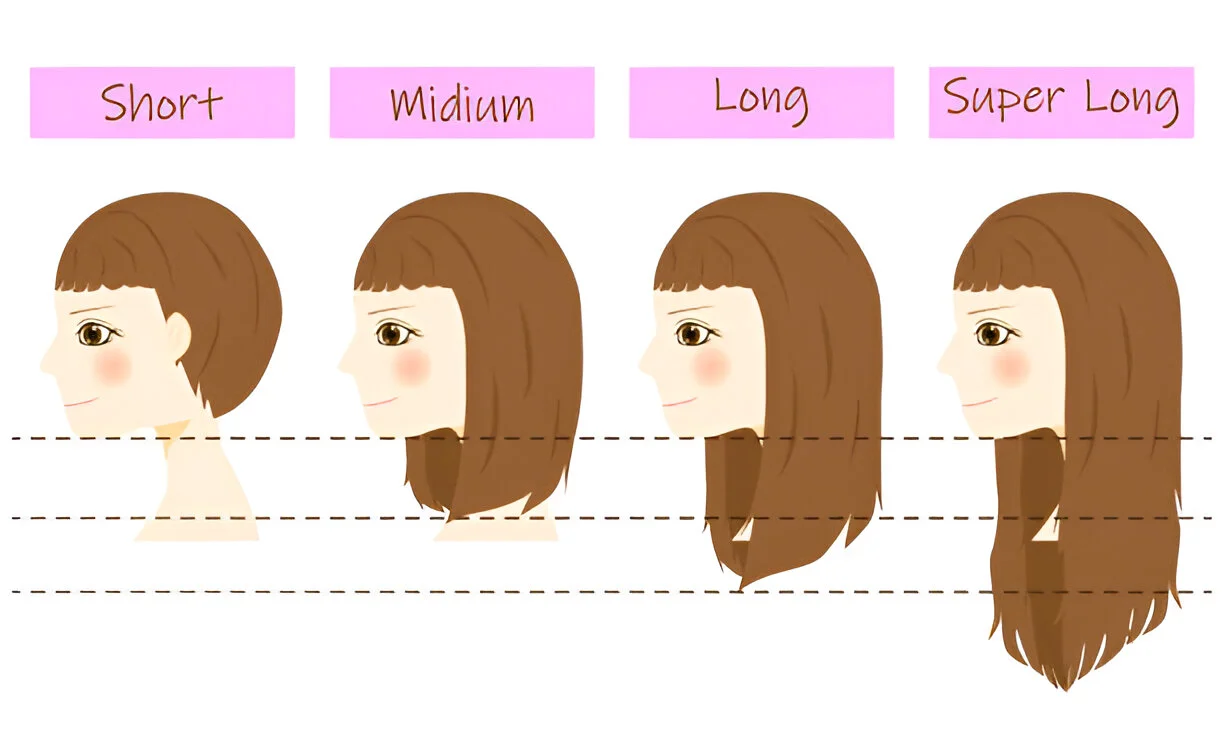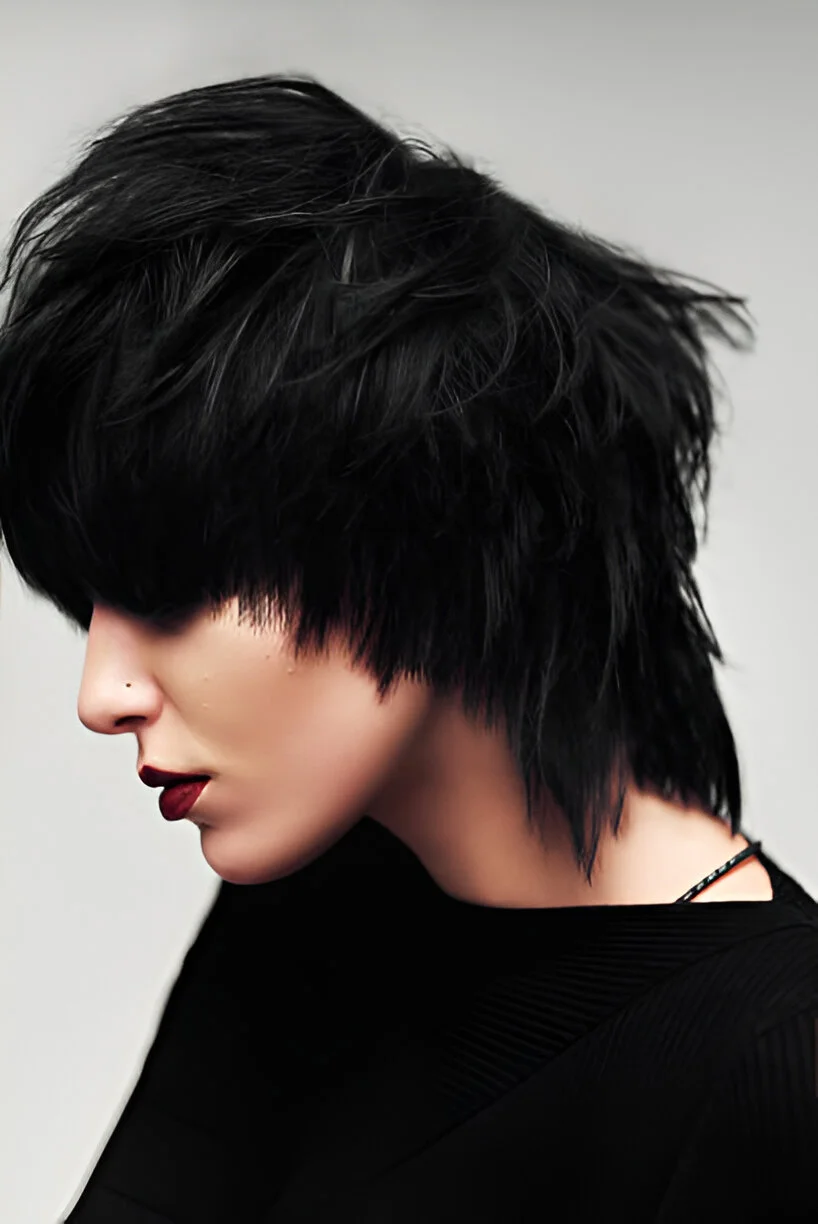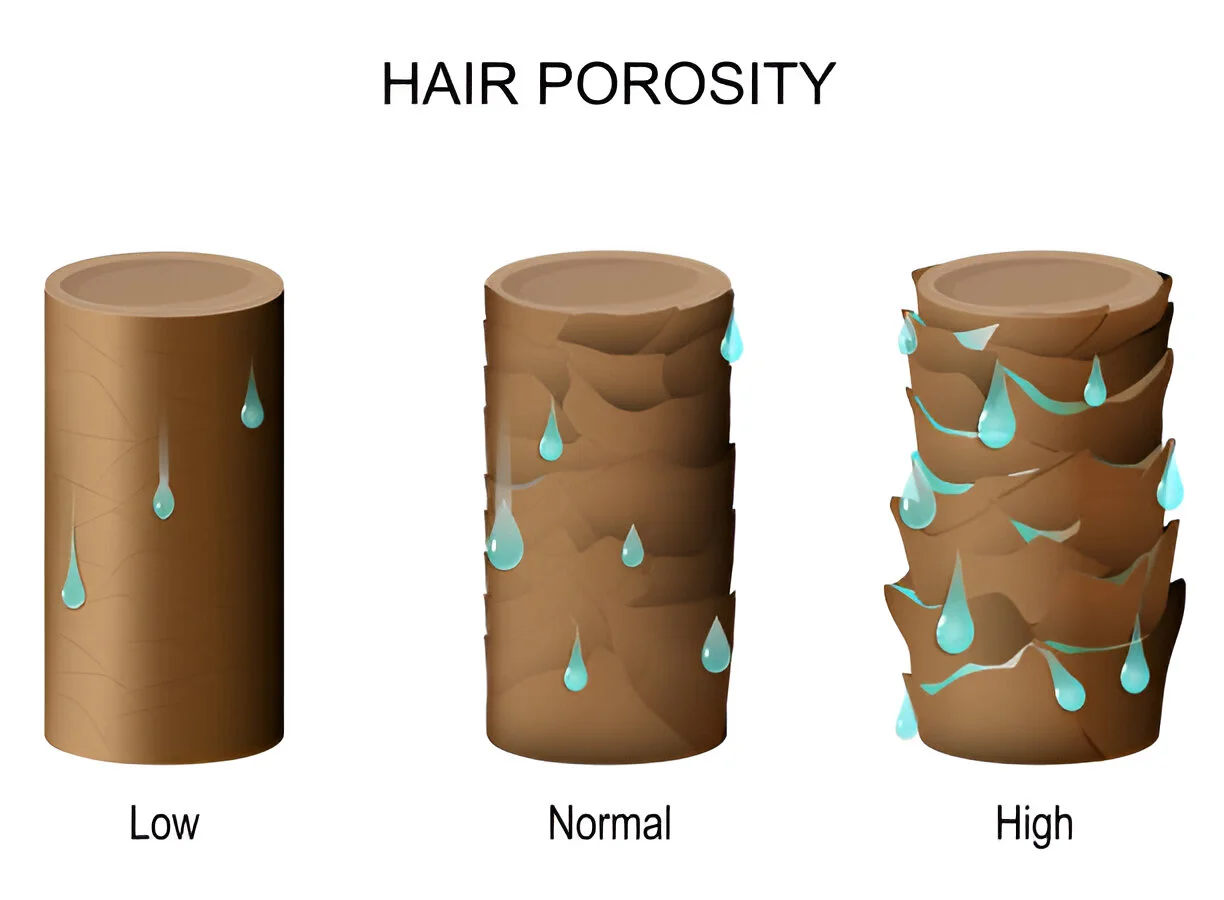Have you ever wondered exactly how long your hair is or what a stylist means when they refer to “shoulder-length” or “mid-back” hair? A hair length chart is here to solve that confusion! Whether you’re planning your next haircut, tracking growth progress, or communicating with your stylist, understanding hair length measurements is essential for achieving your hair goals.
In this comprehensive guide, we’ll explore everything you need to know about hair length charts, from the most common lengths to measuring techniques and styling tips. Let’s dive into the world of hair length and find your perfect style!
What Is a Hair Length Chart?
A hair length chart is a visual guide that illustrates different hair lengths and their standard measurements. It serves as a universal reference point that both professional stylists and individuals can use to identify and communicate about specific hair lengths accurately.
Hair length charts are incredibly useful tools for several reasons:
- They provide clear communication between you and your stylist about your desired haircut
- They help you set realistic hair growth goals and track your progress
- They assist in determining which styles and techniques work best for specific lengths
- They’re invaluable for DIY haircuts and trims at home
- They help when shopping for extensions or wigs to match your natural hair
Having a reliable hair length chart on hand eliminates confusion and ensures everyone is on the same page about what “mid-length” or “long” hair actually means.
The 10 Hair Lengths Explained
Let’s break down the most common hair lengths found on a standard hair length chart, along with styling recommendations for each.
1. Pixie Cut

Description: A pixie cut typically measures 0.5-2 inches at the top and sides, with hair kept above the ears and nape of the neck. It’s one of the shortest options on the hair length chart.
Best for: Fine or thin hair that needs volume, oval or heart-shaped faces, and those wanting a bold, low-maintenance style.
Styling tip: Use texturizing products like pomade or styling wax to create definition and separation. A little product goes a long way with this short length.
2. Bob Length

Description: Bob length hair typically falls between the chin and shoulders, measuring approximately 2-10 inches depending on the specific style (short bob vs. long bob).
Best for: Thick hair that might be overwhelming at longer lengths, adding layers for movement, and framing round or square face shapes.
Styling tip: Maintain blunt ends for maximum volume, or add subtle layers for texture. A round brush and blow dryer can create the perfect curved ends that define this classic style.
3. Shoulder Length

Description: As the name suggests, this hair reaches the shoulders, measuring about 12 inches from the scalp. It’s a versatile middle point on the hair length chart.
Best for: Nearly all hair types and face shapes, making it one of the most universally flattering options on the hair length chart.
Styling tip: This length offers tremendous versatility—it’s long enough for updos but short enough for easy daily styling. Side parts can add volume, while center parts create symmetry.
4. Armpit Length
Description: Hair that extends to the armpit area, typically measuring 16-18 inches from the scalp. It’s the perfect “medium” length.
Best for: Those transitioning from shorter to longer styles, active lifestyles (can be pulled back easily), and most face shapes.
Styling tip: This length works beautifully with loose waves created with a curling wand or beach spray. It’s also long enough for half-up styles while still maintaining a substantial amount of free-flowing hair.
5. Mid-Back
Description: Hair reaching the middle of the back, usually measuring 20-22 inches from the scalp. This is where hair begins to enter the “long hair” category on the hair length chart.
Best for: Those who want long hair with less maintenance than waist-length, thick hair that needs some length for weight, and elongating round face shapes.
Styling tip: Long layers help prevent this length from looking heavy or triangular. Regular hair trims are important to prevent split ends from moving up the hair shaft.
6. Waist Length
Description: Hair that reaches the natural waistline, measuring approximately 24-28 inches from the scalp.
Best for: Those committed to long hair care, hair with natural wave or curl that shortens the apparent length, and creating dramatic styling options.
Styling tip: Protective nighttime routines become crucial at this length—consider silk pillowcases or loosely braided styles while sleeping to prevent tangles and breakage.
7. Hip Length
Description: Hair reaching the hip bone area, typically measuring 30-36 inches from the scalp. This length requires significant dedication to hair care.
Best for: Those who prioritize hair length as a significant aspect of their personal style, hair with strong, healthy growth patterns.
Styling tip: Regular protein treatments help maintain strength at this length. Wearing hair in loose protective styles (braids, buns) during daily activities minimizes stress on the hair shaft.
8. Classic Length
Description: Hair that reaches the tailbone, measuring about 36-40 inches from the scalp. This is considered extremely long hair.
Best for: Those with naturally straight or minimally textured hair, as curly types would need to be significantly longer to reach this length when straightened.
Styling tip: Oil-based products on the ends help prevent the dryness that’s common at this length, as these ends are often several years old.
9. Thigh Length
Description: Hair extending to the mid-thigh area, measuring approximately 42-48 inches from the scalp.
Best for: Those who view their hair as an art form or significant cultural expression, hair that grows quickly and retains length well.
Styling tip: Learning specialized long-hair styling techniques becomes essential, as standard approaches may not accommodate this exceptional length.
10. Knee Length
Description: Hair reaching the knees, measuring 48+ inches from the scalp. This is the longest standard measurement on most hair length charts.
Best for: Dedicated long-hair enthusiasts who are willing to invest significant time in maintenance.
Styling tip: Professional hair care consultations are recommended for maintaining hair health at this extreme length, as it requires specialized knowledge.
Pro Tip: Having a hair length chart handy as a visual reference can help you track your hair growth journey or communicate precisely with your stylist about your goals.
Instructions for Assessing Your Hair Length with a Hair Length Chart.
Accurately measuring your hair is essential for tracking growth and communicating with stylists. Follow these simple steps:
- Start with dry hair (wet hair stretches and gives inaccurate measurements)
- For curly or wavy hair, decide whether to measure in its natural state or straightened
- Stand in front of a mirror or ask someone to assist you
- Use a soft measuring tape, such as the type commonly used for sewing
- Place the beginning of the tape at your scalp where your hair growth starts
- Stretch the tape along your hair to the ends
- Note the measurement and compare it to the hair length chart
Common mistakes to avoid:
- Measuring wet hair (can add inches that disappear when dry)
- Not considering how curls impact length (curly hair appears shorter)
- Measuring from the front (side or back measurements are standard for hair length charts)
- Not measuring regularly (monthly checks help track progress)
Using a hair length chart regularly helps you understand your growth patterns and set realistic goals. Most people’s hair grows about 1/2 inch per month, though this varies based on genetics, health, and hair care practices.
Selecting the Appropriate Hair Length for Your Face Shape and Hair Type
Finding your perfect length involves considering both your face shape and hair texture. The right hair length chart can simplify this decision-making process.
Face Shapes
Oval: Considered the most versatile face shape, nearly all lengths from the hair length chart work well. From pixie cuts to knee-length locks, choose based on your lifestyle and hair texture.
Round: Lengths that fall below the chin help elongate a round face. Consider shoulder-length or longer styles with layers that frame the face. A hair length chart can help you identify these ideal options.
Square: Soften angular jawlines with lengths that fall at or below the shoulders. Wavy textures at chin length or longer help balance strong facial features.
Heart: Chin to shoulder-length styles complement wider foreheads and narrower jawlines. The bob sections of most hair length charts offer excellent options for heart-shaped faces.
Hair Types
Straight Hair: Holds precise cuts well, making it suitable for geometrical styles like bobs or one-length cuts. Straight hair can often appear longer on a hair length chart because it doesn’t shrink with curl patterns.
Wavy Hair: Medium to long lengths allow waves to develop their natural pattern. Layers enhance wave formation, while too-short styles might result in unwanted poofiness.
Curly Hair: Benefits from length that weighs down the curls appropriately. Consider that curly hair appears shorter than it actually measures on a standard hair length chart—your hair might need to be “hip length” when straight to appear “shoulder length” when curly.
Coily Hair: Length adds weight that can elongate tight curl patterns. When using a hair length chart for coily hair, remember that shrinkage can make hair appear 50-75% shorter than its actual length when stretched.
Using a hair length chart specifically designed for your hair texture can provide more accurate expectations about how certain lengths will look and behave with your unique hair type.
Styling & Maintenance Tips for Every Length
Each hair length requires specific care approaches. Let’s explore maintenance tips based on where your hair falls on the hair length chart.
Short Hair (Pixie to Bob)
Products:
- Lightweight styling sprays for volume
- Texturizing wax or pomade for definition
- Quick-dry formulas for efficiency
Routine:
- Frequent trims every 4-6 weeks to maintain shape
- Daily styling is usually necessary but quick
- Regular scalp care to support healthy new growth
Short hair from the hair length chart requires more frequent salon visits but offers wash-and-go convenience that longer styles can’t match.
Medium Hair (Shoulder to Mid-Back)
Products:
- Heat protectant sprays are essential
- Volumizing mousse for body
- Lightweight oils for ends only
Routine:
- Trims every 8-12 weeks
- Strategic layering maintains shape while growing
- Deep conditioning treatments twice monthly
Medium lengths from the hair length chart provide the most versatility—they’re long enough for updos but short enough for easy daily care.
Long Hair (Waist to Knee)
Products:
- Intensive deep conditioners
- Bond-building treatments
- Silk scrunchies and protective accessories
- Leave-in conditioners and detanglers
Routine:
- Protective styling becomes necessary
- Gentle detangling practices (wide-tooth combs, working bottom to top)
- Trims every 3-4 months to prevent splits from traveling upward
- Overnight protection (braiding, silk wrapping)
These exceptional lengths from the hair length chart require dedicated care routines that prioritize protection over daily styling changes.
How to Grow Your Hair Using the Hair Length Chart
A hair length chart becomes your best friend when you’re on a growth journey. Here’s how to use it effectively:
- Mark your starting point on the chart
- Set realistic milestone goals (remember: approximately 6 inches per year is typical)
- Take monthly photos against the hair length chart
- Note changes in growth rate and hair health
Tips for healthy growth:
- Prioritize protein-rich foods (eggs, fish, legumes)
- Gentle scalp massages increase blood flow
- Minimize heat styling and chemical treatments
- Consider supplements after consulting healthcare providers
- Reduce friction damage from rough towels or cotton pillowcases
- Trim regularly to prevent splits from traveling up strands
The hair length chart helps maintain motivation during the “awkward stages” of growth by providing visual evidence of progress that might otherwise feel imperceptible day-to-day.
CTA: Bookmark this hair length chart to monitor your progress monthly and stay motivated on your hair growth journey!
FAQs About Hair Length Charts
How often should I update my hair length chart?
Measuring monthly provides the best tracking data without becoming obsessive. Hair typically grows about 1/2 inch per month, though this varies by individual. More frequent measurements might not show noticeable differences.
Can the chart work for curly hair?
Yes, but you’ll need to decide whether to measure your curly hair in its natural state or when stretched/straightened. Many curlies maintain two measurements on their hair length chart: natural and stretched, to understand both their actual length and how their curl pattern affects appearance.
Is the chart useful for hair extensions?
Absolutely! A hair length chart is essential when purchasing extensions to match your natural length or achieve a desired final length. When buying extensions, refer to the chart to understand exactly how long the extensions will fall on your particular body frame.
Final Thoughts
A hair length chart is more than just a measurement tool—it’s a roadmap for your hair journey. Whether you’re growing out a pixie cut, maintaining your perfect length, or communicating with your stylist, having clear references prevents misunderstandings and helps set realistic expectations.
From pixie cuts to knee-length locks, understanding where your hair falls on the hair length chart empowers you to make informed decisions about cuts, styles, and care routines. Remember that your ideal length should complement both your face shape and lifestyle requirements.
Keep your hair length chart handy as you explore different styles, track growth progress, or prepare for your next salon visit. The more informed you are about your hair’s measurements, the better equipped you’ll be to achieve your hair goals.
Ready to find your perfect length? Start with our comprehensive hair length chart today and take the guesswork out of your hair journey!








2 thoughts on “Hair Length Chart: 10 Lengths Explained in Minutes”
Comments are closed.